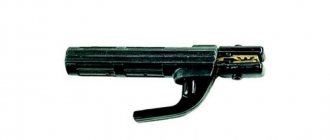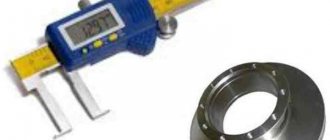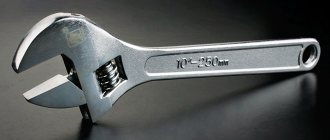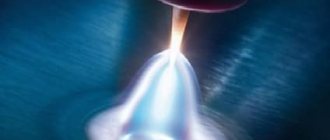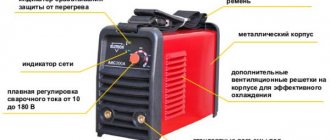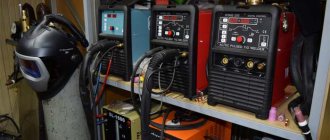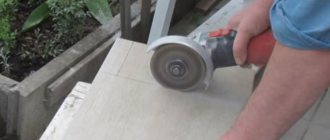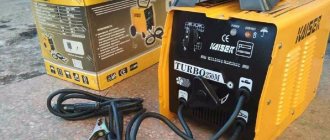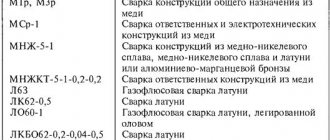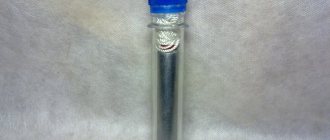Types and purpose of welding electrodes
With welding you can:
- connect metal parts;
- manufacture metal structures of any size;
- cut metal;
- eliminate cracks;
- cut round and shaped holes;
- weld metal to restore wear areas;
- carry out repairs and other types of work.
The industry produces many types of electrodes, about two hundred of them. Each of them is most effective within the limited characteristics of these works, so the choice of electrodes for welding is a very important step. It should be done after thoroughly studying the topic or with the help of specialists.
The criteria for selecting electrodes are the design parameters, characteristics and purpose specified by the product manufacturer. The main ones are:
- electrode brand;
- appointment;
- core diameter;
- type of electrode coating;
- electrode length;
- the magnitude of the working current;
- type of current and polarity of connection;
- composition of the central rod;
- welding position;
- special technological characteristics of the welding process.
Welding electrode device
Despite the fact that the scope of application of welding electrodes may be different, their design is almost always the same. All of them consist of such basic elements as:
- Rod (metallic or non-metallic);
- Coverage (in rare cases may be absent);
- The contact end is uncoated.
The rod is the main part that provides the additional metal needed to connect the individual parts. When exposed to high temperatures, it melts, filling the capacity of the weld pool. The more its composition corresponds to the metal with which it is used, the higher the quality of the seam.
The coating creates a protective environment during welding. Thanks to this, unnecessary objects do not fall into the bath. The selection of coating also depends on the welding conditions and the material with which the work will be carried out, so the choice should be taken very responsibly.
The contact end is used to ignite the arc, which is why it is not coated. Small chipping of parts of the coating in this area is allowed, since this is one of the most vulnerable places.
Welding electrode device
Purpose
The brand of the electrode, as a rule, encrypts its purpose. For example, product types:
- UONI - designed for welding parts at low temperatures;
- ANO-21 - for performing work with thin (up to 4 mm) parts operated under low pressure;
- MP-3S - for welding rolled parts and medium-carbon steels up to 20 mm thick;
- LEZ - for surfacing worn parts;
- inexpensive universal-use OZS-12 electrodes are recommended for welding carbon steels and are easy to use;
- rutile products of the ANO-4 grade are used for welding low-alloy and low-carbon steels; work on both direct and alternating currents; They cook metal contaminated with rust well, have a stable arc, and are easily cleaned of slag.
Experts distinguish between electrodes for welding, tacking, surfacing and cutting. Universal products are in great demand, saving a lot of time when performing various types of work.
Total information
It is worth finding out what welding electrodes are. According to the terminology, it is a welding rod in the form of a rod, which is made of electrically conductive material. The latter is a conductor of electricity from the unit to the mechanism.
Over the past 10 years, more than 100 brands of electrodes have come into use, which are used for various purposes. Metalworking is the most common use of components.
A typical electrode has a length of 2.5 to 4.5 cm. During their production, craftsmen take electrode wires for welding, which are covered with a protective layer. It prevents oxidation and improves the quality of the weld joint.
The end of the electrode is not covered so that the rod penetrates into the holder.
There are melting and non-melting models. The first type quickly decreases under the influence of welding combustion. During melting, the electrodes are connected to the base materials in a special bath.
They need to be replaced when about 70% of the product is used. Don't leave the accessory too short so that it gets stuck in the holder.
Electrodes that do not burn are made of refractory metal. They can hold temperatures up to 3000 degrees. Such electrodes melt the metal, but do not themselves deform.
Welders do not notice their reduction. The welded joint is formed by the action of the base metal.
Diameter
The choice of electrode (core) diameter is determined by the thickness of the parts being welded and the maximum current of the welding machine used. The higher they are, the thicker the connected elements can be.
All three parameters are dependent on each other. Their values are indicated in special tables, which are convenient to use before work and purchasing electrodes. So, for parts with a thickness of 3-4 mm, you need to use electrodes with a diameter of 3 mm with adjustable operating current within the range of 80-160 A.
SSSI 13/55
It is important to use electrodes from this company only with constant current, but they are used even in difficult places where access can be extremely difficult. During operation, welding turns out to be very strong and reliable, since carbon dioxide is released during the process, which allows you to achieve quality.
The design uses a special coating, which has both a positive and negative side. The fact is that such an electrode is very difficult to ignite, and also to re-ignite, so beginners can fiddle with this for a long time.
On the other hand, the use of this technology allows you to gain in reliability. And the seams turn out smooth and beautiful.
Read here: How to assemble a simple welding machine at home: drawings of inverter models and step-by-step assembly instructions
The advantages include the absence of excessive slag impurities, the aesthetics of the seam, the low purchase price and wide popularity among sellers and buyers.
In addition to difficulties with ignition, the negative quality is the time it takes to get used to the product and learn how to work with it.
Coating of electrodes
The core coating is a solid composition, a kind of flux, designed to protect the molten metal from the harmful effects of oxygen, which, when it enters the liquid metal, forms oxides that deteriorate the quality of the connection.
Another function of the coating is to thermally insulate the melt to delay the solidification time (so that harmful gas and non-metallic inclusions have time to escape from it). Modern electrodes use several types of coating. The main ones are basic (in the marking of electrodes, indicated by the letter “B”) and rutile (letter “R”).
Basic coating
It is known that it contains calcium salts - carbonate and fluoride. Its advantage is considered to be a low hydrogen content. Typical representatives of electrodes with basic coating are UONI products. Their coating ensures a high-quality seam, both in appearance and in technical indicators: ductility, strength, impact strength.
The electrodes do not form crystalline cracks inside the seam, therefore they are recommended by specialists for critical welding operations and for products operated in harsh climatic conditions. They can be used when welding in any position except vertical.
Classification of welding electrodes
Due to the fact that a huge mass of their varieties are now being produced, it is quite difficult to make a single classification, therefore, it is possible to derive the main parameters by which the differences are determined. It is worth highlighting separately:
- non-metallic, which includes only infusible electrodes made of coal or graphite;
- Non-consumable metals, such as itrolated, lanthanated, thoriated and the most common - tungsten;
- Consumable metal without coating, which often looks like an ordinary long wire, is now rarely used and mainly for welding in shielding gases, which compensate for the lack of coating;
- Metal melting with a coating is the most common type. This includes cast iron, steel, copper, bronze, aluminum, stainless and other welding electrodes.
Rutile coating
Rutile is titanium dioxide. In addition to it, the coating contains silicon and oxygen.
Rutile coating is characterized by the following properties:
- formation of a high-quality seam at any spatial position of the electrode;
- stable arc burning;
- minimal splashing of melt and coating;
- possibility of welding on both direct and alternating currents;
- possibility of welding rusty and dirty parts;
- quick and easy ignition of the electrode;
- easy removal of slag.
Main types of electrodes
The composition of the electrode coating has a significant impact on the performance characteristics of the consumable.
Sour
In coatings of this type, the slag-forming components are oxides of iron and manganese, and less commonly titanium. There are brands with added silica. In order to form a gas protection, organic substances are introduced into the mixture: oxycellulose, dextrin, starch.
Silica is added to acidic electrodes.
Advantages:
- The workpieces do not need to be cleaned of rust and scale. Pores do not form in the seam, since the slags of acidic coatings bind iron oxides.
- It is possible to cook with a long arc (at increased voltage). Some other consumables produce a porous seam under such conditions.
- The arc stability is high, which allows welding with alternating current. The discharge is easily re-ignited. A transformer with a relatively low open-circuit voltage is suitable - 60-70 V.
- High deposition rate ensures good productivity. For some brands it reaches 11-12 g/A*h.
- Seams can be made in all spatial positions.
Flaws:
- The coating produces a large volume of free oxygen, which binds alloying elements. This does not allow the use of acid electrodes for welding structures made of high-alloy steel grades.
- Organic components saturate the surfacing with hydrogen. Because of this, consumables are not suitable for hardening steels (high-carbon and alloyed). Hydrogen penetrates into the seam zone and deprives the material of plasticity, as a result of which cold cracks appear. In addition, during the crystallization process it forms pores: if the proportion of silicon is more than 0.1-0.2%, manganese - more than 0.8-0.9% (deoxidized steel).
- Gaseous manganese compounds are released that are harmful to health.
- The weld material exhibits a tendency to hot cracks when the carbon content in the steel exceeds 0.15%. For this reason, only low-carbon steels are welded with acid consumables.
- A large amount of splashes is generated.
- The seam has low impact strength and is prone to mechanical aging due to its saturation with oxygen.
Consumables are not suitable for hardening steels.
In terms of chemical composition, the metal deposited with acid electrodes from low-carbon welding wire corresponds to boiling steel (the share of silicon is below 0.1%). According to its mechanical properties, consumables correspond to the value E38-E42.
We recommend reading Calculation of electrode consumption during welding
Products with acid coating are produced under the brands TsM-7, SM-5, OMM-5, MEZ-4. Due to their high toxicity, their use is limited. Replacement with rutile acid is recommended.
Basic (b)
The coating is dominated by minerals containing calcium and magnesium carbonate: marble, dolomite, fluorspar or magnesite. When burned, the carbon they contain turns into carbon dioxide and carbon monoxide. At the same time, magnesium and calcium oxides are formed.
Advantages:
- No organic component. Thanks to this, the metal is not saturated with hydrogen, as is the case with other types of coatings. This element already present in the melt is bound by calcium fluoride contained in the coating. This prevents steel embrittlement, allowing the use of basic electrodes for welding hardenable grades (high-carbon and alloyed). Such consumables are called low-hydrogen.
- High impact strength of the seam. Consumables are suitable for the manufacture of structures operating at low temperatures and experiencing dynamic loads.
- Lower susceptibility of the deposited metal to aging than other coatings.
- High coefficient of slag basicity. This ensures good absorption of alloying elements. Basic electrodes are the only consumable electrodes that are suitable for welding high-alloy steels.
- "Short" slags. They harden quickly when cooled, which makes it possible to make vertical and ceiling seams.
- High resistance of surfacing to the formation of hot cracks.
The electrodes have a high slag basicity coefficient.
The latter circumstance makes consumables with a basic coating most suitable for the following tasks:
- manufacturing of rigid structures;
- performing multilayer seams of large thickness;
- welding steel with high carbon and sulfur content.
Disadvantage: low arc stability. The fluorine contained in the coating serves as a deionizer. Therefore, electrodes with a basic coating are used to cook primarily at a direct current of reverse polarity. The exception is products with the addition of potash or liquid glass that can operate with alternating voltage. These substances serve as a source of potassium and sodium - elements with low ionization potential. Potash absorbs water well; drying requires a temperature of 350-400°C.
Factors of increased porosity:
- The presence of scale and rust on the surface of the workpiece. The slags of the main coating do not bind iron oxides, and they cause disturbances in the structure of the metal.
- Coating humidity is from 2-2.5%. Water acts as a source of hydrogen, which is actively absorbed by deoxidized steel.
- Long arc and large gaps. The gas protection of the material deteriorates and it becomes saturated with nitrogen. In addition to porosity, steel embrittlement and susceptibility to aging are observed.
In terms of chemical composition, the metal deposited with an electrode made from low-carbon welding wire corresponds to mild steel (the share of Si is 2-5%). According to its mechanical characteristics, consumables correspond to the designation E42A-E50A.
Brands of electrodes with basic coating: LKZ-70, SM-11, UONI-13/45, UONI-13/55, NIAT-3M, etc.
Products UP-1/55 and UP-2/55 can be cooked using alternating current.
Cellulose (c)
This type of coating is made primarily of flammable organic substances. Cellulose, wood and grass flour are used for this purpose. Talc, organic resins, and ferroalloys are added.
Cellulose electrodes consist of flammable organic substances.
Advantages:
- Large volume of protective gases and small amount of slag. This allows for high-quality welds with low porosity in all spatial positions.
- Great penetration depth. It is explained by the displacement of metal from the weld pool by the flow of gases.
- Stable arc burning.
Disadvantage: increased splashability.
Large penetration depth plays an important role in the following connections:
- one-sided, performed in weight;
- pipeline joints (this forms the root of the seam);
- in others, produced under installation conditions.
This type of consumables is not suitable for the following designs:
- Made from high-carbon and alloy steels (prone to hardening). The organic component saturates the metal in the weld pool with hydrogen. It penetrates into the seam zone and deprives the steel of its plasticity, as a result of which cold cracks appear.
- Made from high carbon steel with a high proportion of sulfur. The seam is prone to hot cracks.
- With strict requirements for assembly quality regarding clearances.
Cellulose consumables are not suitable for high carbon steel.
Electrodes of the brands OMA-2, TsTs-1, VSTs-2, VSTs-3, VSTs-4A, VSTs-60, OMA-2 have a cellulose coating. They are mainly used for welding low carbon steels. When joining low-alloy steel workpieces using such consumables, only the root of the seam is welded.
Rutile (r)
The mineral rutile is mainly composed of titanium dioxide. In addition to it, the coating contains ferromanganese, silica, chalk or magnesium carbonate.
Product advantages:
- Minimal splashing.
- Easy separation of scale. The seam has a neat appearance.
- Arc stability, fast re-ignition. This ensures high performance.
- Safety for the health of the welder.
- Versatility. Varieties are available for any task, incl. mixed (rutile-cellulose, etc.).
- "Short" slags.
- The ability to reliably connect workpieces covered with rust, scale or primer (with a thickness of up to 20-25 microns).
- Resistant to hot cracks.
- Smooth transition from the seam to the base metal. Thanks to this, connections experiencing alternating loads have high fatigue resistance.
Rutile electrodes consist of titanium dioxide.
In terms of the chemical composition, the material deposited with products made from low-carbon welding wire corresponds to semi-mild steel (the proportion of Si is 0.1-0.2%). According to its mechanical properties, the electrodes correspond to the designation E42-E46.
We recommend reading Characteristics and operation of non-consumable electrodes
In most cases, organic additives are introduced as gas-forming agents. This leads to saturation of the melt with hydrogen and, as a consequence, increased porosity of the weld. These indicators are within acceptable limits if the coating is not overdried.
To do this, the following conditions are met:
- consumables are calcined at a temperature of +200°C for 60 minutes;
- work begins a day after the procedure.
Other factors of increased porosity:
- excessive current;
- welding of thin metal with large diameter consumables;
- making T-joints with a gap.
Electrodes of the MR-3, ANO-1, OZS-4, OZS-6, ZRS-1, ZRS-2 brands have a rutile coating.
Rutile electrodes marking
Current source
To weld metals with electrodes, welding transformers, rectifiers, inverters and other devices operating in manual arc welding mode are used. The inverter is widely used due to its compactness, light weight and wide capabilities.
It provides operation on both direct and alternating current, and its light weight is explained by the fact that voltage transformation is performed at a frequency not of 50 Hz, but of 100 kHz, for which the size and weight of the transformer core is reduced by an order of magnitude.
When welding with direct current, the polarity of the connection matters. With direct polarity, the ground (welding part) is connected to the “+” of the source, and the holder with the electrode is connected to “-”. With reverse polarity, the opposite is true. With direct polarity you can weld thin parts, and with reverse polarity you can weld massive parts.
When selecting electrodes, using the table and data on the welding machine, you can determine whether the source can provide the required amount of current.
Coating thickness
It has its own designation in the instrument marking. It is determined by the coefficient of its ratio D (mm) to the thickness of the rod itself d (mm). Distributed into 4 groups:
- thin “M” (coefficient up to 1.2);
- average “C” (the coefficient has values ranging from 1.2 to 1.45);
- thick “D” (coefficient – in the range of 1.45-1.8);
- especially thick “G” (coefficient value over 1.8).
The results of the work are influenced not only by the types of coatings of manual arc welding electrodes, but also by the thickness of the coating layer itself, as well as the dimensions of the rod. Correct selection of the electrode size ensures good speed of work, quality parameters of the arc and the formed connection.
Welding position
The spatial position of the electrode is also included in its marking. The number 1 denotes electrodes that are used for welding only in the lower position of the part (electrode on top).
The number 2 marks products used with a horizontal or vertical seam (ceiling is excluded).
Number 3 is used for ceiling electrodes (the electrode rests on the part from below). The welder must take these markings into account to avoid a poor-quality weld or injury.
Calcination of electrodes
Coating of electrodes requires tightness during storage, but this condition is not met everywhere. The sharp edges of the rods, as a rule, break the tightness of the plastic packaging already during the first transfer of packs. Thus, by the time of purchase, the electrodes are saturated with excess atmospheric moisture.
In this condition, due to the danger of obtaining a poor-quality seam and the possibility of too much metal spattering, welding cannot be performed with them. The electrodes need to be dried. The manufacturer gives clear recommendations regarding process parameters, setting drying time and maximum temperature. It usually does not exceed 260 ºС.
How to determine the quality of electrodes when purchasing?
The best option would be to test several electrodes from the purchased batch in the welding workflow. If this is not possible, you need to pay attention to the following factors:
- shelf life of products;
- name of the manufacturing company (for experienced welders this is important information);
- quality of coating in terms of uniform thickness of application around the rod, absence of crumbling.
If during testing there are signs of excessive moisture, the electrodes should be dried and the test repeated.
In order for the welding of parts to be carried out in accordance with all the rules of the regulations, and the quality of the seam not to be criticized, it is extremely important to study welding technologies well. The choice of electrode type is an integral part of this knowledge, which needs to be constantly replenished and improved.
